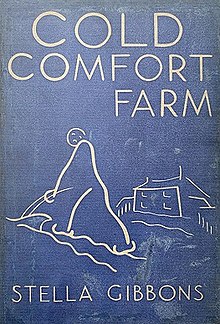Cold Comfort Farm

First edition
|
|
| Author | Stella Gibbons |
|---|---|
| Country | United Kingdom |
| Language | English |
| Genre | Comic novel |
| Publisher | Longman |
|
Publication date
|
8 September 1932 |
| Media type | Print (hardback) |
| Pages | xii, 307 pp |
| ISBN | (current Penguin Classics edition) |
Cold Comfort Farm is a comic novel by English author Stella Gibbons, published in 1932. It parodies the romanticised, sometimes doom-laden accounts of rural life popular at the time, by writers such as Mary Webb. Gibbons was working for the Evening Standard in 1928 when they decided to serialise Webb's first novel, The Golden Arrow, and Gibbons was given the job of summarising the plot of earlier instalments. Other novelists in the tradition parodied by Cold Comfort Farm are D. H. Lawrence, Sheila Kaye-Smith and Thomas Hardy; and going further back, Mary E. Mann and the Brontë sisters. Cold Comfort Farm won the Femina Vie Heureuse Prize for 1933. In 2003, the novel was listed at number 88 on the BBC's survey The Big Read.
Following the death of her parents, the book's heroine, Flora Poste, finds she is possessed "of every art and grace save that of earning her own living." She decides to take advantage of the fact that "no limits are set, either by society or one's own conscience, to the amount one may impose on one's relatives", and settles on visiting her distant relatives at the isolated Cold Comfort Farm in the fictional village of Howling in Sussex. The inhabitants of the farm — Aunt Ada Doom, the Starkadders, and their extended family and workers — feel obliged to take her in to atone for an unspecified wrong once done to her father.
As is typical in a certain genre of romantic 19th-century and early 20th-century literature, each of the farm's inhabitants has some long-festering emotional problem caused by ignorance, hatred, or fear, and the farm is badly run. Flora, being a level-headed, urban woman, determines that she must apply modern common sense to their problems and help them adapt to the 20th century.
As parody of the "loam and lovechild" genre of historical novel, Cold Comfort Farm alludes specifically to a number of novels both in the past and currently in vogue when Gibbons was writing. According to Faye Hammill's Cold Comfort Farm, D. H. Lawrence, and English Literary Culture Between the Wars, the works of Sheila Kaye-Smith and Mary Webb are the chief influence. According to Hammill, the farm is modelled on Dormer House in Webb's The House in Dormer Forest, and Aunt Ada Doom on Mrs. Velindre in the same book. The farm-obsessed Reuben's original is in Kaye-Smith's Sussex Gorse, and the Quivering Brethren on the Colgate Brethren in Kaye-Smith's Susan Spray.
...
Wikipedia
